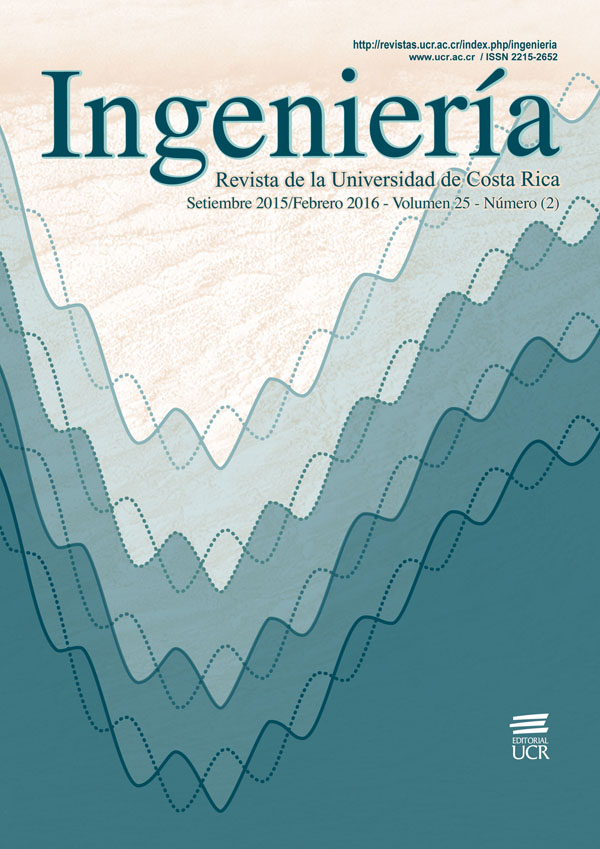Abstract
When radars operate in coastal or offshore environments, an undesired signal known as clutter appears as background in the measurements. The CA-CFAR detector is the classic solution for the detection of targets inside clutter, typically using a fixed value for its adjustment factor the entire period of operation. Using MATLAB, the author simulates the CA-CFAR response under amplitude samples from the classical sea clutter Weibull distribution. As a result, a relation between operating conditions (Weibull shape parameter) and the most efficient adjustment factor is obtained for various false alarm probabilities. Thus, the implementation of a new detector that achieves the adaptation to changing environments through the use of a variable adjustment factor is suggested. Note that sea environment is present in most radar scenarios both in military and meteorological applications.
References
Antipov, I. (1998). Simulation of Sea Clutter Returns. Australia: DSTO Electronic and Surveillance Research Laboratory.
Bacallao Vidal, J. C. (2003). Un modelo Teórico de la Técnica DRACEC. Metodología del Proceso de Adaptación al Fondo: Instituto Técnico Militar “José Martí”.
Barton, D.K., Leonov, S. A.(1998). Radar Technology Encyclopedia (Electronic
Edition) London: Artech House.
Caso, G. , De Nardis, L.(2013). Cooperative Spectrum Sensing based on Majority decision under CFAR and CDR constraints. Workshop on Cognitive Radio Medium Access Control and Network solutions. IEEE 24th International
Symposium on Personal, Indoor and Mobile Radio communications. London, UK.
de Figueiredo, F. (2013). AP. LTE Random Access Detection Based on a CA-CFAR Strategy. Sao Pablo, Brazil: Convergent Networks Department, Research and Development Center campinas.
Farina, A., Studer, F. A. (1986) A Review of CFAR Detection Techniques in Radar Systems. Horizon House-Microwave Inc.
Haykin, S., Bakker, R., Currie, B. W. (2002) Uncovering Nonlinear Dynamics—The Case Study of Sea Clutter. Proceedings of the IEEE, 90(5).
Ishii, S., Sayama, S., Mizutani, K. (2011). Effect of Changes in Sea-Surface State on Statistical characteristics of Sea Clutter with X-band Radar. Wireless Engineering and Technology, 2(3).
Jian-bo Hu, J. T., Wen-wen G. (2009). Modeling sea clutter as a nonstationary and nonextensive random process. IEEE Conference on Radar Issues.
Jian-bo Hu, J. T., Wen-wen, G. (2009) A New Way to Model Nonstationary Sea Clutter. IEEE Signal Processing Letters, 16(2).
Kouemou, G.(2009). Radar Technology: I-Tech. London: Artech House.
Kumar Yadav, A., Kant, L. (2013). Moving Target Detection using VI-CFAR Algorithm on MATLAB Platform. International Journal of Advanced Research in Computer Science and Software Engineering.
Machado Fernández, J. R., Bueno González, A.(2012) Clasificación del Clutter Marino utilizando Redes Neuronales Artificiales. Habana: Instituto Superior Politécnico José Antonio Echeverría (ISPJAE).
Machado Fernández, J. R. (2014). Empleo de las Redes Neuronales Artificiales en la estimación de los Parámetros del Clutter Marino distribuido Weibull. Congreso Internacional de Telecomunicaciones y Telemática. Convención Científica de Ingeniería y Arquitectura; Palacio de Convenciones de la Habana, Cuba.
Machado Fernández, J. R., Bacallao Vidal, J. C. (2014). MATE-CFAR: ambiente de Pruebas para detectores CFAR en Matlab. Telem@tica, Revista Digital de las Tecnologías de la Información y las Comunicaciones, 13 (3):86-98.
Machado Gil, A., García Delgado, B. (2014). Reconocimiento de Parámetros Asociados a distribuciones del Clutter Marino con Redes Neuronales Artificiales. La Habana, Cuba: Instituto Superior Politécnico José Antonio Echeverría (ISPJAE).
Magaz, B., Belouchrani, A. (2011). Automatic Threshold Selection in OS-CFAR Radar detection using Information Theoretic Criteria. Progress In Electromagnetics Research,p. 157-75.
Mashade, M. B. (2013). Performance Analysis of the Modified Versions of CFAR Detectors in Multiple-Target and Nonuniform Clutter. Radioelectronics and Communications Systems, 56(8).
Nagle, D. T. (1991). Analysis of Robust Order Statistic CFAR Detectors. Illiniois: Illinois Institute of Technology.
O’Connor, A. N. (2011). Probability Distributions Used in Reliability Engineering. Maryland: University of Maryland.
Oyedokun, O. (2012). Sea Clutter Simulation. Cape Town: University of Cape Town.
Qin, Y., Gong, H. (2013). A New CFAR Detector based in Automatic Censoring Cell Averaging and Cell Averaging. TELKOMNIK,11(6): 3298 - 303.
Ranjan, D. S., Krishna Moorthy, H. (2013).Development of Adaptive Algorithm for CFAR in non-homogenous environment. International Journal of Engineering and Innovative Technology (IJEIT), 3(1).
Rohling, H. (1983). Radar CFAR Thresholding in Clutter and Multiple Target Situations. IEEE Transactions on Aerospace and Electronic Systems,19(4).
Sayama, S., Ishii, S. (2013). Suppression of Log- Normal Distributed Weather Clutter Observed by an S- and Radar. Wireless Engineering and Technology, 4(3).
Skolnik, M. I.(2008). Radar Handbook. New York: McGraw-Hill.
Takahashi, S. (2010) A CFAR Circuit of Detecting Spatially Correlated Target for Automotive UWB Radars. Hiroshima City University: Faculty of Information Sciences.
Totir, F., Rador, E., Anton, L. (2008) Advanced Sea Clutter Models and their Usefulness for Target Detection. MTA Review.
Van Cao, T-T (2012). Non-homogeneity Detection in CFAR Reference Windows using the Meanto- Mean Ration Test. Australia: DSTO Defence Science and Technology Organisation.
Wawruch, R. (2013). Experimental evaluation of the Constant False Alarm Rate (CFAR) algorithms used in maritime FM-CW radars. Scientific Journals, Maritime University of Szczecin, 36.
Weingberg, G. V. (2004) Estimation of False Alarm Probabilities in Cell Averaging Constant False Alarm Rate Detectors via Monte Carlo Methods. Australia: DSTO Systems Sciences Laboratory.


